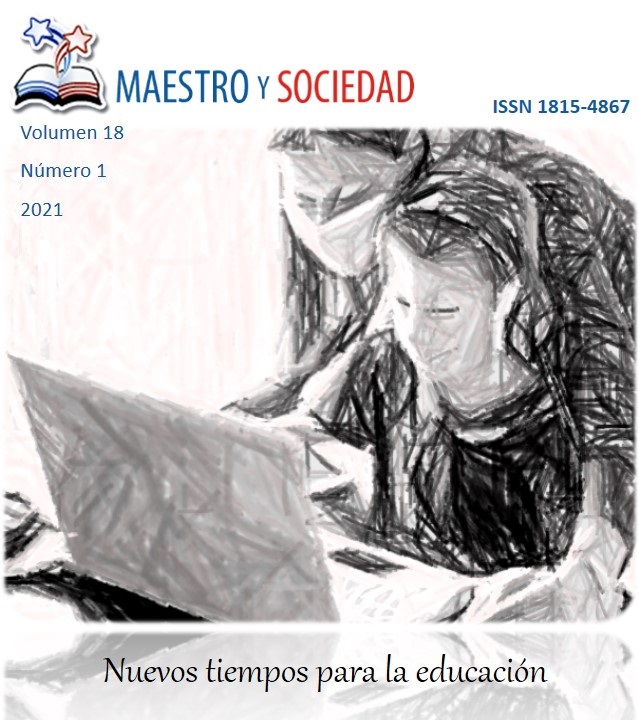Dance and its theoretical-practical conditions to cultivate the environment in the university context
Array
Keywords:
Environment, environmental culture, articulating link of knowledge, environmental awareness.Abstract
The records of the environmental training of education professionals configure a need on the intellectual plane, since the new knowledge on the subject in question is dimensional; since there are international movements that emerged in response to the growing environmental deterioration accumulated in the middle of the last century. On the other hand, dance is a cultural activity that is given in the anonymous popular traditions, in which it contains a complex technical framework. The work provides a system of dance workshops to develop environmental culture from the optional curriculum in the university context. In addition, the analysis-synthesis methods and the system approach were used for a logic in terms of the theoretical and practical elements. The results are given in weighing the environmental culture from the appreciation and the dance creation, and thus promote an environmental awareness on the basis of protecting our natural wealth.
References
2. Aguiar, E. (2015). La formación ambiental del tutor en las microuniversidades. (Tesis de doctorado). Universidad de Ciencias Pedagógicas Félix Varela Morales”, Las Villa Clara, Cuba.
3. Aricó, H. (2007). Breves reflexiones sobre la danza. Recuperado de http://elbaile.com.ar/2017/06/24/breves-reflexiones-sobre-la-danza/
4. Gutiérrez, D. (2014). El taller como estrategia didáctica. Recuperado de http://www.razonypalabra.org.mx/N/n66/varia/dgutierrez.html
5. Hernández, M. A. (2012). Bailes populares cubanos. La Habana: Editorial Pueblo y Educación.
6. Mc Pherson, M. (2004). La dimensión ambiental en la formación inicial de docentes en Cuba. Una estrategia metodológica para su incorporación. (Tesis de doctorado). Instituto Central de Ciencias Pedagógicas, La Habana, Cuba.
7. Novoa, E. (2006). Expresión Corporal. La Habana: Editorial Adagio.
8. Ochoa, M., Castellanos, R., Ochoa, Z. y Oliveros, JL. (2015). Variabilidad y cambio climáticos: su repercusión en la salud. Recuperado de http://scielo.sld.cu/scielo.php?script=sci_arttext&pid=S1029-30192015000700008&lng=es.
9. Rosales, L. (2019). La danza como estrategia de innovación educativa para la sensibilización ambiental. Recuperado de https://www.monografias.com/docs114/danza-innovacion-educativa-sensibilizacion-ambiental/danza-innovacion-educativa-sensibilizacion-ambiental.shtml.
10. Sánchez, P. y Morales, X. (2000). Educación musical y expresión corporal. La Habana: Editorial Pueblo y Educación.
11. Sescovich, S. (2013). El proceso de enseñanza-aprendizaje: el taller como modalidad técnico-pedagógica. Recuperado de https://es.scribd.com/doc/59271172/Concepto-Taller
12. Turmin Pérez-Lambert, T., C. Librada García-Leiva, C., Pérez-Matos, R. y Sonia Vidal-Trimiño, S. (2020). La formación de valores y la educación ambiental en carreras pedagógicas de Ciencias Naturales. Revista Maestro y Sociedad, 17(2), 311-322. Recuperado de https://maestroysociedad.uo.edu.cu
13. Villamil Velandia, I. M. (2018). Propuesta didáctica de educación ambiental para el desarrollo de la conciencia y el conocimiento ambiental. (Tesis de pregrado). Universidad de Ciencias Aplicadas y Ambientales U.D.C.A, Bogotá, Colombia. Recuperado de https://repository.udca.edu.co/bitstream/11158/988/1/Documento%20Final%20para%20entrega%20Jun-19.pdf
Published
How to Cite
Issue
Section
License
This journal provides immediate open access to its content, based on the principle that offering the public free access to research helps a greater global exchange of knowledge. Each author is responsible for the content of each of their articles.



























 Universidad de Oriente
Universidad de Oriente 